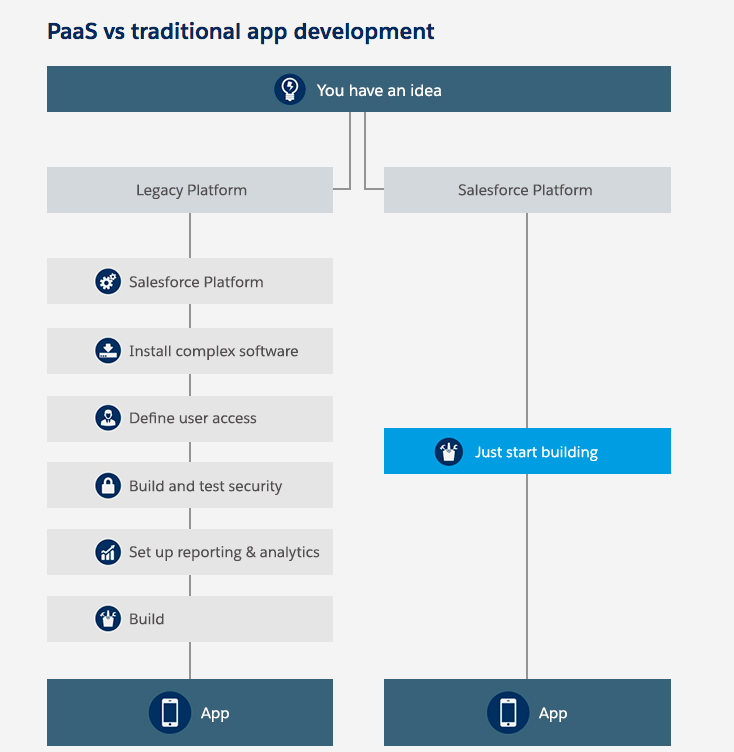Here’s what you need to know about PaaS.
What is PaaS?
Let’s start with a brief definition care of Sunil Joshi on the IBM blog:
Platform as a service (PaaS) is a cloud-based computing environment designed to support the rapid development, running, and management of applications. It is integrated and abstracted from the lower-level infrastructure components.
There’s a lot in there, so let’s unpack it a bit.
PaaS is a cloud-based computing environment. Basically, it’s a product/service offered through the cloud to companies, just like Google Docs or Adobe’s Creative Suite.
designed to support the rapid development, running, and management of applications. It supports the development of applications, both desktop applications (e.g. a CRM) and mobile apps (e.g. Clash of Clans).
It is integrated and abstracted from the lower-level infrastructure components. This is the important bit. What this means is the level beneath PaaS – the underlying infrastructure of servers and hardware and uptime and connections and so on – is completely abstracted. This comes included when you deal with PaaS – organizations don’t have to worry about it.
With that in mind, here’s our definition of Platform-as-a-Service:
PaaS is a cloud computing service that gives organizations a platform to build on while providing enough structure so things like the hardware are taken care of. It’s comprised mainly of runtimes (like Java runtimes), databases (like MySQL, Oracle), and web servers (tomcat etc). It’s used by organizations who have some software they want to launch but need an environment to do it in.
One way to think about it is like a house.
When using PaaS, someone else has built the framework and connected the electrical and plumbing. Now, you’ve come in to put up walls and lights and fixtures so your house suits your needs.
PaaS: 2 Examples
There are dozens of PaaS examples. Here are 2 that make it easy to understand.
Heroku, purchased by Salesforce for $212 million eight years ago, is the stereotypical PaaS product. They’re designed so that app developers can use Heroku to cover off all the boring stuff like middleware to go from server hardware to software, runtime, and even an operating system so that the developers can focus on building apps.
They have many languages so developers can work how they want, and their past clients include companies like Citrix’s GoToMeeting, Yesware, and Macy’s.
 Image via Heroku
Image via Heroku
We know that Heroku is now owned by Salesforce, but any discussion of PaaS can’t be completed without mentioning them.
Salesforce offers a few PaaS benefits that other networks lack. Specifically, they offer an app marketplace so anyone who builds an app on top of their PaaS platform can find an audience as soon as they go live. Their platform is also more catered to B2B applications, meaning it’s built with security and data sharing in mind from the start.
For companies looking to build new apps for their companies, Salesforce.com is hard to look past (if, of course, you’re already using Salesforce).

Image via Salesforce
Why PaaS is important

Finally, we get to the relevant question: why is any of this important?
Basically, PaaS offers all the benefits of SaaS products compared to on-premise but offers those benefits not to consumers of technology but to the people who make it.
These benefits include:
- Rapid deployment
- Instant scaling
- Reduced cost
But also include benefits like:
- Faster building times
- Simpler building environments
- Access to code libraries
- Streamlined integrations with other applications
- Instant go to market strategy.
In short, PaaS makes it easier to build and launch end-products to get them to market faster.
As Heroku puts it on their site:
Setting up, operating and maintaining your own platform is not where the race is won. Avoid the risk and complexity, and dedicate your energy to what matters: building great apps.
And that’s exactly what PaaS offers — specialization, giving developers the time to focus on what they’re good at — building apps we all want to use and businesses want to buy.
Summary
Understanding why PaaS products are a good way to build products isn’t hard. It means developers who excel at dreaming up new apps and building them in such a way that people love to use them can focus on that, instead of focusing on the nitty-gritty details involved in getting (and keeping) a secure hosting environment up and running.
As Sunil Joshi put it:
It is integrated and abstracted from the lower-level infrastructure components.
That abstraction means developers can walk into a house that’s already got the frame, electrical, and plumbing up and running — ready for them to turn it into the Next Big Idea.
